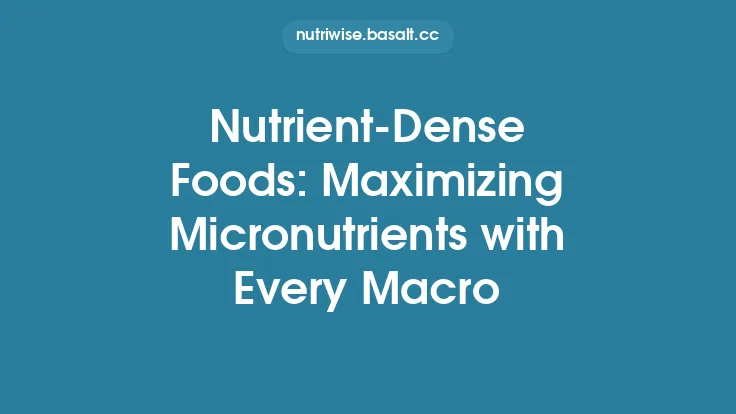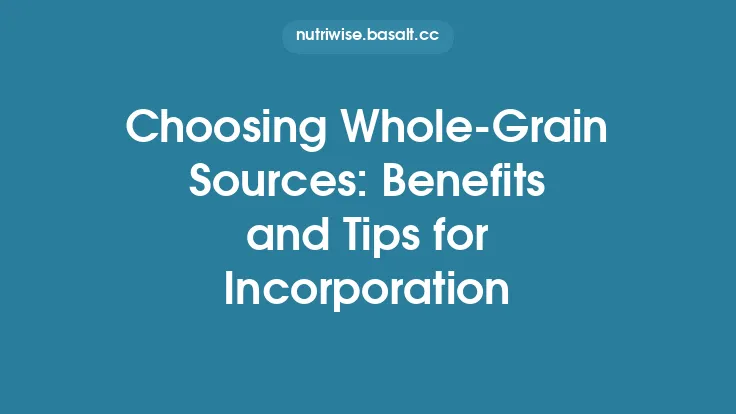Egg substitutes are the cornerstone of vegan baking, allowing you to recreate the rise, moisture, binding, and richness that eggs traditionally provide—without compromising on nutrition or flavor. While many home bakers reach for the first “flax‑egg” they find online, a deeper understanding of the science behind each alternative can elevate your baked goods from merely acceptable to consistently excellent. Below is a comprehensive guide to the most reliable, nutrient‑dense egg replacements, how they work, and practical tips for integrating them into a wide range of recipes.
Understanding What Eggs Do in Baked Goods
Before diving into specific substitutes, it helps to know the four primary roles eggs play in baking:
- Leavening – The proteins in egg whites trap air when whisked, helping cakes and soufflés rise.
- Binding – Egg yolk proteins coagulate during baking, holding ingredients together (think cookies that don’t crumble).
- Moisture – Eggs contribute water, which keeps crumb structures tender.
- Emulsification & Flavor – The lecithin in yolks blends fats and liquids, creating a smooth texture and adding richness.
A good vegan egg substitute should mimic one or more of these functions while also contributing a nutritional boost—protein, healthy fats, fiber, vitamins, or minerals.
1. Flaxseed Meal “Egg” – The Classic Binder & Moisture Provider
How it works: Ground flaxseed mixed with water forms a gelatinous mucilage that mimics the binding and moisture‑retaining properties of eggs.
Standard ratio: 1 tablespoon ground flaxseed + 3 tablespoons water → 1 “egg”. Let sit 5‑10 minutes until thickened.
Nutrient profile (per tablespoon of ground flaxseed):
- Calories: 37
- Protein: 1.3 g
- Fiber: 2 g (mostly soluble)
- Omega‑3 ALA: 2.4 g
- Lignans (phytoestrogens) and antioxidants
Best uses: Quick breads, muffins, pancakes, and cookies where a modest rise is acceptable. Not ideal for airy cakes that rely heavily on egg‑white foam.
Tips for success:
- Use freshly ground flaxseed for maximum mucilage.
- Whisk vigorously to avoid clumps.
- For extra lift, combine with a small amount of baking powder or soda.
2. Chia Seed “Egg” – Fiber‑Rich Binding with a Crunchy Edge
How it works: Like flax, chia seeds swell into a gel when hydrated, but they also retain a slight crunch if not fully pureed, adding texture.
Standard ratio: 1 tablespoon whole or ground chia seeds + 3 tablespoons water → 1 “egg”.
Nutrient profile (per tablespoon of chia seeds):
- Calories: 58
- Protein: 2 g
- Fiber: 5 g (mostly soluble)
- Omega‑3 ALA: 2.5 g
- Calcium, magnesium, and iron
Best uses: Dense brownies, oat bars, and fruit‑filled muffins where a subtle seed texture is welcome.
Tips for success:
- Blend the chia‑water mixture briefly if you prefer a smoother gel.
- Allow at least 10 minutes for full hydration.
- Pair with a small amount of apple cider vinegar to enhance leavening in recipes that call for baking soda.
3. Aquafaba – The Egg‑White Stand‑In for Light, Airy Bakes
How it works: Aquafaba is the viscous liquid from cooked chickpeas (or canned chickpea brine). Its protein and saponin content can be whipped into stiff peaks, replicating egg‑white foam.
Standard ratio: 3 tablespoons aquafaba → 1 large egg white; 2 tablespoons aquafaba → 1 whole egg (when combined with a binder).
Nutrient profile (per 100 ml of aquafaba):
- Calories: 30‑40
- Protein: 0.5‑1 g
- Carbohydrates: 5‑6 g (mostly sugars)
- Sodium: 200‑300 mg (varies by brand)
Best uses: Meringues, macarons, angel food cakes, soufflés, and vegan mayonnaise.
Tips for success:
- Use a stand mixer on high speed; add a pinch of cream of tartar to stabilize.
- For extra lift, incorporate ¼ teaspoon of baking powder per cup of aquafaba.
- Store aquafaba in the refrigerator for up to a week; freeze in ice‑cube trays for longer storage.
4. Silken Tofu – Protein‑Heavy Binding and Moisture
How it works: Silken tofu’s high water content and neutral flavor make it an excellent binder that also adds a creamy texture.
Standard ratio: ¼ cup (≈60 g) silken tofu, blended smooth → 1 large egg.
Nutrient profile (per ¼ cup):
- Calories: 45
- Protein: 4 g
- Calcium: 10 % DV (if calcium‑set)
- Iron: 4 % DV
- No cholesterol, low saturated fat
Best uses: Dense cakes, brownies, custard‑style desserts, and vegan cheesecakes.
Tips for success:
- Press gently to remove excess water if you need a firmer texture.
- Blend with a splash of vanilla or citrus zest for flavor.
- Combine with a small amount of baking powder for a lighter crumb in muffins.
5. Commercial Egg‑Replacer Powders – Consistency and Convenience
How they work: Most powders contain a blend of starches (potato, tapioca), leavening agents (baking powder, sodium bicarbonate), and sometimes gums (xanthan, guar). The starch gelatinizes during baking, providing binding and moisture, while the leavening agents create lift.
Typical usage: Follow package instructions—commonly 1 teaspoon powder + 2 tablespoons water = 1 egg.
Nutrient considerations:
- Generally low in protein and fiber, but some brands fortify with calcium, iron, or B‑vitamins.
- Calorie count is modest (≈20‑30 kcal per serving).
Best uses: When you need a neutral‑flavored, reliable substitute across a wide range of recipes, especially in commercial or large‑batch settings.
Tips for success:
- Whisk the reconstituted mixture thoroughly to avoid lumps.
- For extra richness, add a teaspoon of melted coconut oil or a splash of plant‑based milk.
- Store in a cool, dry place; the powder is shelf‑stable for years.
6. Nut‑Based “Eggs” – Richness and Protein Boost
a. Almond or Cashew Butter + Water
How it works: Blended nut butter with water creates an emulsion that mimics the fat and binding properties of yolks.
Standard ratio: 1 tablespoon nut butter + 2 tablespoons water → 1 egg.
Nutrient profile (per tablespoon almond butter):
- Calories: 98
- Protein: 2.5 g
- Healthy monounsaturated fats: 8 g
- Vitamin E, magnesium, and calcium
Best uses: Cookies, brownies, and crusts where a nutty flavor complements the final product.
Tips for success:
- Use a high‑speed blender for a smooth mixture.
- Add a pinch of salt to balance sweetness.
b. Sunflower Seed “Egg”
How it works: Soaked and blended sunflower seeds produce a thick paste that binds and adds a subtle earthy note.
Standard ratio: ¼ cup soaked sunflower seeds + 2 tablespoons water → 1 egg.
Nutrient profile (per ¼ cup):
- Calories: 150
- Protein: 6 g
- Vitamin E: 30 % DV
- Selenium and magnesium
Best uses: Savory breads, crackers, and vegan quiches.
Tips for success:
- Soak seeds for at least 4 hours or overnight.
- Strain excess water before blending to control consistency.
7. Fruit‑Based Egg Replacements – Sweet Moisture with Antioxidants
a. Mashed Overripe Banana
How it works: The natural sugars and pectin in banana provide moisture and a mild binding effect.
Standard ratio: ¼ cup mashed banana → 1 egg.
Nutrient profile (per ¼ cup):
- Calories: 55
- Potassium: 180 mg
- Vitamin C and B6
- Small amount of fiber
Best uses: Sweet breads, pancakes, and muffins where banana flavor is welcome.
Tips for success:
- Use only very ripe bananas (black skins) for maximum sweetness.
- Pair with a pinch of cinnamon or nutmeg to enhance flavor.
b. Unsweetened Applesauce
How it works: Applesauce adds water and pectin, acting as a binder and moisture source.
Standard ratio: ¼ cup applesauce → 1 egg.
Nutrient profile (per ¼ cup):
- Calories: 25
- Vitamin C: 2 % DV
- Small amount of fiber
Best uses: Light cakes, muffins, and quick breads where a subtle fruit note is acceptable.
Tips for success:
- Choose unsweetened varieties to avoid altering the recipe’s sugar balance.
- Combine with a teaspoon of baking powder for extra lift.
8. Combining Substitutes for Complex Functions
Some baked goods demand both leavening and binding. In such cases, a hybrid approach works best:
- Aquafaba + Flaxseed: Whip aquafaba to incorporate air, then fold in a flax “egg” for binding. Ideal for vegan cupcakes with a tender crumb.
- Silken Tofu + Baking Powder: Blend tofu for moisture, then add a pinch of baking powder to encourage rise in dense brownies.
- Nut Butter + Aquafaba: Create a rich, emulsified base (nut butter + water) and fold in whipped aquafaba for airy, buttery cookies.
Pro tip: When using two substitutes, reduce the total liquid in the original recipe by about ¼ cup to prevent a soggy texture.
9. Nutritional Comparison at a Glance
| Substitute | Protein (g) | Fiber (g) | Omega‑3 (g) | Calories (per egg‑equiv.) | Key Micronutrients |
|---|---|---|---|---|---|
| Flaxseed | 1.3 | 2.0 | 2.4 (ALA) | 37 | Lignans, Vitamin E |
| Chia | 2.0 | 5.0 | 2.5 (ALA) | 58 | Calcium, Magnesium |
| Aquafaba | 0.5‑1.0 | 0.0 | 0.0 | 30‑40 | Sodium (variable) |
| Silken Tofu | 4.0 | 0.5 | 0.0 | 45 | Calcium, Iron |
| Commercial Powder | 0.0‑0.5 | 0.0‑0.5 | 0.0 | 20‑30 | Often fortified |
| Nut Butter | 2.5 | 0.5 | 0.0 | 98 | Vitamin E, Mg |
| Sunflower Seed | 6.0 | 2.0 | 0.0 | 150 | Vitamin E, Selenium |
| Banana | 0.6 | 1.5 | 0.0 | 55 | Potassium, B6 |
| Applesauce | 0.2 | 0.5 | 0.0 | 25 | Vitamin C |
*Values are approximate and based on standard serving sizes.*
10. Practical Tips for Consistent Results
- Measure Precisely – Egg substitutes can be more forgiving than real eggs, but accurate ratios ensure predictable texture.
- Adjust Leavening – When replacing eggs that contributed lift, increase baking powder or soda by ¼ ‑ ½ teaspoon per egg omitted.
- Mind Flavor Profiles – Some substitutes (banana, nut butter) impart distinct tastes; choose based on the final flavor you desire.
- Test Small Batches – Before scaling up, bake a mini‑loaf or a single cookie to gauge how the substitute behaves in your specific recipe.
- Storage – Keep dry powders airtight; refrigerate wet gels (flax, chia) if not using immediately; freeze aquafaba for long‑term use.
- Combine for Texture – For crumbly cookies, add a teaspoon of xanthan gum alongside a binder to improve cohesion without altering flavor.
11. Frequently Asked Questions
Q: Can I use the same substitute for both sweet and savory recipes?
A: Yes, but consider the flavor impact. Neutral options like aquafaba, silken tofu, or commercial powders work well across the board, while fruit‑based substitutes are best reserved for sweet applications.
Q: Are these substitutes suitable for gluten‑free baking?
A: Absolutely. Egg substitutes themselves are gluten‑free; just ensure any added leavening agents or powders are certified gluten‑free if that’s a requirement.
Q: How do I achieve a glossy finish on vegan pastries?
A: Brush the baked surface with a thin layer of maple syrup, agave nectar, or a mixture of plant‑based milk and a dash of oil. This does not replace the egg’s role but adds visual appeal.
Q: Do any of these substitutes contain allergens?
A: Yes. Nut butter, sunflower seed, and soy‑based tofu are common allergens. Flax, chia, and aquafaba are generally hypoallergenic, but always check for cross‑contamination if you’re baking for others.
12. Building Your Own Egg‑Substitute Toolkit
To keep your vegan pantry ready for any baking challenge, consider stocking the following core items:
- Ground flaxseed (whole and pre‑ground)
- Chia seeds (whole or milled)
- Canned chickpeas (for aquafaba)
- Silken tofu (refrigerated)
- Commercial egg‑replacer powder (e.g., Ener-G, Bob’s Red Mill)
- Unsweetened applesauce (jarred)
- Ripe bananas (keep a few on hand)
- Almond or cashew butter (smooth)
- Sunflower seeds (for soaking)
With these staples, you’ll be equipped to tackle everything from airy cupcakes to dense brownies, all while delivering a nutrient boost that traditional eggs simply can’t match.
Closing Thoughts
Egg substitutes are far more than a workaround for dietary restrictions; they are an opportunity to enrich baked goods with protein, fiber, healthy fats, and micronutrients. By understanding the functional role each substitute plays—and by selecting the right one for the specific texture and flavor you aim to achieve—you can bake vegan treats that are consistently delicious, nutritionally superior, and entirely reliable. Happy baking!





